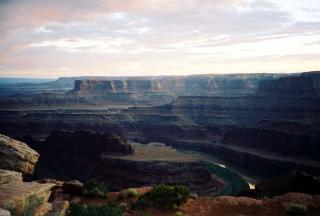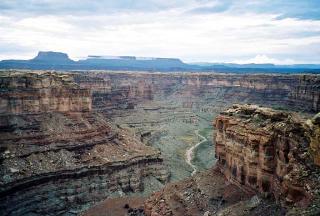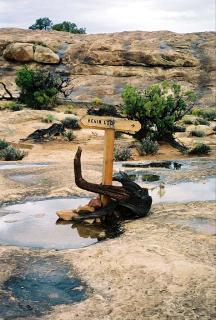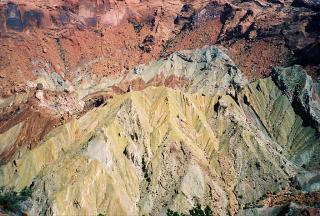Sunday, October 16, 2005
Canyonlands
The Utah Adventure, Part III
 On the evening after our second day in Arches NP, we drove a bit further up the road out of Moab to Dead Horse Point State Park. The view, as you can see, was quite spectacular, and even moreso because we were there at sunset. The triangular bit of land you can see there is called Dead Horse Point because cowboys used to use it as a natural corral for wild horses since the drop is so steep at the point, roping the horses they wanted and letting the rest go afterward. One of the less responsible cowboys, though, left his herd trapped and wandered off, leaving them to die of dehydration.
On the evening after our second day in Arches NP, we drove a bit further up the road out of Moab to Dead Horse Point State Park. The view, as you can see, was quite spectacular, and even moreso because we were there at sunset. The triangular bit of land you can see there is called Dead Horse Point because cowboys used to use it as a natural corral for wild horses since the drop is so steep at the point, roping the horses they wanted and letting the rest go afterward. One of the less responsible cowboys, though, left his herd trapped and wandered off, leaving them to die of dehydration.
From the Dead Horse Point overlook, though, what you are really looking out into is not the state park, but Canyonlands National Park. This park is so big, it has been divided into three separate districts, Needles, Island in the Sky, and the Maze, each with its own entrance and divided from the other districts by the Green and White Colorado Rivers forming natural boundaries within the park. It is actually one of the less mapped and trailed parks that I've been to in the US, so if you want to see much of the districts, you have to be prepared for some serious hiking and camping. What has been trailed out, though, is enough to give you a definite desire to see more.
 The next day we set out for the Needles district. Its entrance is actually about 2 hours away from Moab, and the land takes on quite a different aspect just that far away from Arches. While Arches is mostly red rock and desert feel, Needles has a lot more green on its rocks. In addition, while Arches struck me as a very interactive park where you felt like you could walk up and touch the rocks, Canyonlands is much more sweeping vistas and majestic canyons that can only be taken in from afar. We nearly had the park to ourselves because, about 20 minutes after arriving, it began to rain quite hard. We retreated to the visitor center parking lot and entertained ourselves by playing travel Scrabble in the car until the rain stopped. When it did let up and we could see again, pretty much everyone else had given up and left.
The next day we set out for the Needles district. Its entrance is actually about 2 hours away from Moab, and the land takes on quite a different aspect just that far away from Arches. While Arches is mostly red rock and desert feel, Needles has a lot more green on its rocks. In addition, while Arches struck me as a very interactive park where you felt like you could walk up and touch the rocks, Canyonlands is much more sweeping vistas and majestic canyons that can only be taken in from afar. We nearly had the park to ourselves because, about 20 minutes after arriving, it began to rain quite hard. We retreated to the visitor center parking lot and entertained ourselves by playing travel Scrabble in the car until the rain stopped. When it did let up and we could see again, pretty much everyone else had given up and left.
 We ended up doing the Slickrock Trail, one of the shorter ones in the park, because by the time the rain ended, we didn't have 4-5 hours to devote to one hike before it got too dark to find our way back to the car. According to the map, Slickrock will only take 2 hours. We probably spent 3 or more, because we took every single minor branch to an overlook, and paused to look at neat things. The whole trail was marked only with stone cairns on the slickrock, which led to several moments of "Wait, where do we go now?" and looking around for the next pile of rocks, but we learned to trust that the park service knew what it was doing in setting out the trail, because each overlook point we came to was spectacular. With all the rain, too, Andrew decided that all the strange, wet rock formations looked like what Mars would be if there was rain and vegetation. When the sun went down, though, we had to go, with the wish that we had come more prepared to do more serious exploration.
We ended up doing the Slickrock Trail, one of the shorter ones in the park, because by the time the rain ended, we didn't have 4-5 hours to devote to one hike before it got too dark to find our way back to the car. According to the map, Slickrock will only take 2 hours. We probably spent 3 or more, because we took every single minor branch to an overlook, and paused to look at neat things. The whole trail was marked only with stone cairns on the slickrock, which led to several moments of "Wait, where do we go now?" and looking around for the next pile of rocks, but we learned to trust that the park service knew what it was doing in setting out the trail, because each overlook point we came to was spectacular. With all the rain, too, Andrew decided that all the strange, wet rock formations looked like what Mars would be if there was rain and vegetation. When the sun went down, though, we had to go, with the wish that we had come more prepared to do more serious exploration.
 The next day we hit the Island in the Sky district of the park, which is the district Dead Horse Point Park looks into. The entrance to Island in the Sky is conveniently located on the way out of Moab. I say convenient because this was our last day in the area. We had to be back in Salt Lake City by that evening so we could get to the airport in time the next day. In quite a change from our previous lack-of-schedule existence on this vacation, this day I had a schedule in mind, with the best route of all the important sights of the park mapped out with suggestions from a park ranger at the visitor's center. Andrew did not particularly like being zipped through the park in such a manner, but he will have to admit that we saw pretty much the whole thing in 3 hours. We started out at the Upheaval Dome, which entailed a short hike to get to the overlook of the extremely bizarre land formation which is either a salt dome that has been pushed up out of the earth or a meteor impact crater. Given that it is more than 90 million years old, though, all the evidence that would tell us whether it was a meteor impact crater for sure has long since eroded. The salt dome theory is the more accepted one now, which you can read more about at the link above.
The next day we hit the Island in the Sky district of the park, which is the district Dead Horse Point Park looks into. The entrance to Island in the Sky is conveniently located on the way out of Moab. I say convenient because this was our last day in the area. We had to be back in Salt Lake City by that evening so we could get to the airport in time the next day. In quite a change from our previous lack-of-schedule existence on this vacation, this day I had a schedule in mind, with the best route of all the important sights of the park mapped out with suggestions from a park ranger at the visitor's center. Andrew did not particularly like being zipped through the park in such a manner, but he will have to admit that we saw pretty much the whole thing in 3 hours. We started out at the Upheaval Dome, which entailed a short hike to get to the overlook of the extremely bizarre land formation which is either a salt dome that has been pushed up out of the earth or a meteor impact crater. Given that it is more than 90 million years old, though, all the evidence that would tell us whether it was a meteor impact crater for sure has long since eroded. The salt dome theory is the more accepted one now, which you can read more about at the link above.
 Besides this geological oddity, though, what Island in the Sky is really known for is its views. It truly is like looking down from an island in the sky, because the canyons are so far below you. Looking at my pictures now, they practically look like I took them from an airplane. We only got to do the short little hikes out to the various overlooks, but they were definitely worth it. When we hiked out to Mesa Arch, Andrew of course had to climb on top, which no one had really thought anything of in Arches, but here in the more sedate, viewing-oriented climate of Canyonlands had German tourists taking pictures of him. It seemed a fitting end to the vacation adventure.
Besides this geological oddity, though, what Island in the Sky is really known for is its views. It truly is like looking down from an island in the sky, because the canyons are so far below you. Looking at my pictures now, they practically look like I took them from an airplane. We only got to do the short little hikes out to the various overlooks, but they were definitely worth it. When we hiked out to Mesa Arch, Andrew of course had to climb on top, which no one had really thought anything of in Arches, but here in the more sedate, viewing-oriented climate of Canyonlands had German tourists taking pictures of him. It seemed a fitting end to the vacation adventure.
On the way back to Salt Lake City, we stopped back by the dinosaur museum in Price to get an insanely bright stuffed dinosaur for baby Daniel, Selwyn the neon orange and raspberry plush chasmosaur, which we presented to Daniel's parents upon seeing them again before retiring to a hotel. Marian has since reported that Selwyn has become Daniel's favorite toy, I suspect mostly due to the brightness of coloration. Alas, the next day we did indeed have to wake up and board planes to return to our mundane lives, far from strange geological wonders and fantastic hiking trails.
The Utah Adventure, Part III
 On the evening after our second day in Arches NP, we drove a bit further up the road out of Moab to Dead Horse Point State Park. The view, as you can see, was quite spectacular, and even moreso because we were there at sunset. The triangular bit of land you can see there is called Dead Horse Point because cowboys used to use it as a natural corral for wild horses since the drop is so steep at the point, roping the horses they wanted and letting the rest go afterward. One of the less responsible cowboys, though, left his herd trapped and wandered off, leaving them to die of dehydration.
On the evening after our second day in Arches NP, we drove a bit further up the road out of Moab to Dead Horse Point State Park. The view, as you can see, was quite spectacular, and even moreso because we were there at sunset. The triangular bit of land you can see there is called Dead Horse Point because cowboys used to use it as a natural corral for wild horses since the drop is so steep at the point, roping the horses they wanted and letting the rest go afterward. One of the less responsible cowboys, though, left his herd trapped and wandered off, leaving them to die of dehydration.From the Dead Horse Point overlook, though, what you are really looking out into is not the state park, but Canyonlands National Park. This park is so big, it has been divided into three separate districts, Needles, Island in the Sky, and the Maze, each with its own entrance and divided from the other districts by the Green and White Colorado Rivers forming natural boundaries within the park. It is actually one of the less mapped and trailed parks that I've been to in the US, so if you want to see much of the districts, you have to be prepared for some serious hiking and camping. What has been trailed out, though, is enough to give you a definite desire to see more.
 The next day we set out for the Needles district. Its entrance is actually about 2 hours away from Moab, and the land takes on quite a different aspect just that far away from Arches. While Arches is mostly red rock and desert feel, Needles has a lot more green on its rocks. In addition, while Arches struck me as a very interactive park where you felt like you could walk up and touch the rocks, Canyonlands is much more sweeping vistas and majestic canyons that can only be taken in from afar. We nearly had the park to ourselves because, about 20 minutes after arriving, it began to rain quite hard. We retreated to the visitor center parking lot and entertained ourselves by playing travel Scrabble in the car until the rain stopped. When it did let up and we could see again, pretty much everyone else had given up and left.
The next day we set out for the Needles district. Its entrance is actually about 2 hours away from Moab, and the land takes on quite a different aspect just that far away from Arches. While Arches is mostly red rock and desert feel, Needles has a lot more green on its rocks. In addition, while Arches struck me as a very interactive park where you felt like you could walk up and touch the rocks, Canyonlands is much more sweeping vistas and majestic canyons that can only be taken in from afar. We nearly had the park to ourselves because, about 20 minutes after arriving, it began to rain quite hard. We retreated to the visitor center parking lot and entertained ourselves by playing travel Scrabble in the car until the rain stopped. When it did let up and we could see again, pretty much everyone else had given up and left. We ended up doing the Slickrock Trail, one of the shorter ones in the park, because by the time the rain ended, we didn't have 4-5 hours to devote to one hike before it got too dark to find our way back to the car. According to the map, Slickrock will only take 2 hours. We probably spent 3 or more, because we took every single minor branch to an overlook, and paused to look at neat things. The whole trail was marked only with stone cairns on the slickrock, which led to several moments of "Wait, where do we go now?" and looking around for the next pile of rocks, but we learned to trust that the park service knew what it was doing in setting out the trail, because each overlook point we came to was spectacular. With all the rain, too, Andrew decided that all the strange, wet rock formations looked like what Mars would be if there was rain and vegetation. When the sun went down, though, we had to go, with the wish that we had come more prepared to do more serious exploration.
We ended up doing the Slickrock Trail, one of the shorter ones in the park, because by the time the rain ended, we didn't have 4-5 hours to devote to one hike before it got too dark to find our way back to the car. According to the map, Slickrock will only take 2 hours. We probably spent 3 or more, because we took every single minor branch to an overlook, and paused to look at neat things. The whole trail was marked only with stone cairns on the slickrock, which led to several moments of "Wait, where do we go now?" and looking around for the next pile of rocks, but we learned to trust that the park service knew what it was doing in setting out the trail, because each overlook point we came to was spectacular. With all the rain, too, Andrew decided that all the strange, wet rock formations looked like what Mars would be if there was rain and vegetation. When the sun went down, though, we had to go, with the wish that we had come more prepared to do more serious exploration. The next day we hit the Island in the Sky district of the park, which is the district Dead Horse Point Park looks into. The entrance to Island in the Sky is conveniently located on the way out of Moab. I say convenient because this was our last day in the area. We had to be back in Salt Lake City by that evening so we could get to the airport in time the next day. In quite a change from our previous lack-of-schedule existence on this vacation, this day I had a schedule in mind, with the best route of all the important sights of the park mapped out with suggestions from a park ranger at the visitor's center. Andrew did not particularly like being zipped through the park in such a manner, but he will have to admit that we saw pretty much the whole thing in 3 hours. We started out at the Upheaval Dome, which entailed a short hike to get to the overlook of the extremely bizarre land formation which is either a salt dome that has been pushed up out of the earth or a meteor impact crater. Given that it is more than 90 million years old, though, all the evidence that would tell us whether it was a meteor impact crater for sure has long since eroded. The salt dome theory is the more accepted one now, which you can read more about at the link above.
The next day we hit the Island in the Sky district of the park, which is the district Dead Horse Point Park looks into. The entrance to Island in the Sky is conveniently located on the way out of Moab. I say convenient because this was our last day in the area. We had to be back in Salt Lake City by that evening so we could get to the airport in time the next day. In quite a change from our previous lack-of-schedule existence on this vacation, this day I had a schedule in mind, with the best route of all the important sights of the park mapped out with suggestions from a park ranger at the visitor's center. Andrew did not particularly like being zipped through the park in such a manner, but he will have to admit that we saw pretty much the whole thing in 3 hours. We started out at the Upheaval Dome, which entailed a short hike to get to the overlook of the extremely bizarre land formation which is either a salt dome that has been pushed up out of the earth or a meteor impact crater. Given that it is more than 90 million years old, though, all the evidence that would tell us whether it was a meteor impact crater for sure has long since eroded. The salt dome theory is the more accepted one now, which you can read more about at the link above. Besides this geological oddity, though, what Island in the Sky is really known for is its views. It truly is like looking down from an island in the sky, because the canyons are so far below you. Looking at my pictures now, they practically look like I took them from an airplane. We only got to do the short little hikes out to the various overlooks, but they were definitely worth it. When we hiked out to Mesa Arch, Andrew of course had to climb on top, which no one had really thought anything of in Arches, but here in the more sedate, viewing-oriented climate of Canyonlands had German tourists taking pictures of him. It seemed a fitting end to the vacation adventure.
Besides this geological oddity, though, what Island in the Sky is really known for is its views. It truly is like looking down from an island in the sky, because the canyons are so far below you. Looking at my pictures now, they practically look like I took them from an airplane. We only got to do the short little hikes out to the various overlooks, but they were definitely worth it. When we hiked out to Mesa Arch, Andrew of course had to climb on top, which no one had really thought anything of in Arches, but here in the more sedate, viewing-oriented climate of Canyonlands had German tourists taking pictures of him. It seemed a fitting end to the vacation adventure.On the way back to Salt Lake City, we stopped back by the dinosaur museum in Price to get an insanely bright stuffed dinosaur for baby Daniel, Selwyn the neon orange and raspberry plush chasmosaur, which we presented to Daniel's parents upon seeing them again before retiring to a hotel. Marian has since reported that Selwyn has become Daniel's favorite toy, I suspect mostly due to the brightness of coloration. Alas, the next day we did indeed have to wake up and board planes to return to our mundane lives, far from strange geological wonders and fantastic hiking trails.
Comments:
<< Home
I like your posts about Arches National Park and Canyonland NP. I've been writing a blog about a cross-country trip my family took. I just finished writing about our side trip to Arches on my blog so I thought I'd do a search to see what other people had to say about the area. You can read mine at www.laragans.blogspot.com
My family did a cross-country trip when I was in high school, and it was fantastic. We didn't hit Arches then, though. I've still got so many more parks to visit! Looks like your trip passed through many beautiful places.
Post a Comment
<< Home
